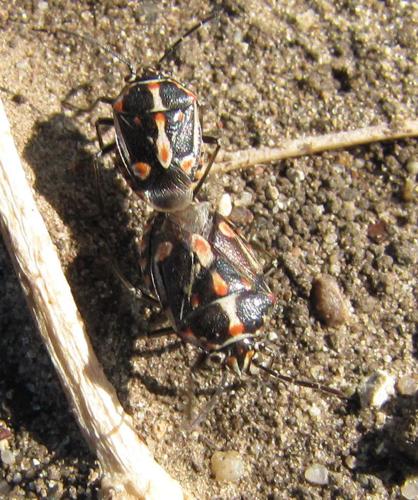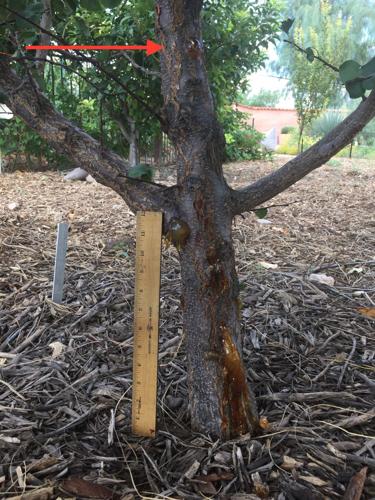Question: Our apricot tree has yellow ooze on the trunk, which we think could be a fruit tree borer. Do you have any words of wisdom about how to control this insect on this tree and others, as well as how we might treat this particular infection?
We’d like to use the IPM approach that you instilled in us. We’ve heard about covering damaged areas of bark, insect traps and other products, poking wires into larvae holes, etc.
Answer: After looking at the tree, I think it might be gummosis rather than a peach tree borer. The main reason is the location of the gum. The borer you mentioned typically attacks less than one foot from the soil line. I see gum higher on the trunk and also some near a pruning cut on the north side of the tree.
The gummosis pathogen is known as Cytospora canker and is caused by a fungus, Leucostoma cincta. It invades and kills bark and cambial tissue through wounds such as pruning cuts, sunscald, hail, etc. Gumming from cytospora is dark amber in color, and if you scrape the outer bark, the dead phloem will appear cinnamon brown in color.
Cytospora canker is an opportunistic pathogen, meaning that it invades trees through wounds. It can be found almost everywhere, so prevention is the key to management. Management for cytospora includes making proper pruning cuts (i.e., do not leave stubs or do not make “flat cuts” that remove the branch collar where healing would normally occur) and do not prune in wet weather.
Affected limbs should be pruned back to healthy wood and make sure you sterilize pruning tools with 10 percent bleach between cuts. If a tree is severely affected, it’s best to remove it and start over. Prevention also includes keeping trees healthy with optimal watering, mulching, nutrition, etc.
Q: Last year I was advised to try swabbing the feeding ports with canola, or like oil to discourage bees at our hummingbird feeders but that doesn’t seem to have any effect this year. I don’t know what kind of bees, and I don’t want to kill them, but I’m tired of them.
A: Planting a variety of flowering plants nearby as an alternative for the bees would likely lessen their visits to your hummingbird feeders. Bees seem to prefer flowers to feeders if they are available. Flowers have chemical cues and visual cues to attract them.
Bees might also visit your feeders for the water. If there hasn’t been any rain lately you could put out a bowl of water with something floating in it so they won’t drown. Just be sure to rinse it out every few days so you don’t breed mosquitoes.
Q: May I call upon your expertise in sharing some insight on this insect attracted to the broccoli starts?
A: That is the bagrada bug (Bagrada hilaris). It was first found in California in June of 2008. Since 2010 it has been found in many parts of Arizona including Yuma, La Paz, Maricopa, Pima and Pinal counties.
This relatively new pest insect is native to Africa, India and Pakistan among others. Although damage attributed to bagrada bugs has been observed in corn, cotton, potatoes plus other crops and weeds, members of the plant family Brassicaceae have been more heavily affected in home gardens. The brassicas include many cool season vegetables, such as kale, mustard, cabbage, arugula, broccoli, cauliflower, radishes, and brussels sprouts.
If your plants are heavily infested you might just pull them up and destroy them. A smaller infestation can be treated with pyrethroid insecticides. If you prefer nonchemical methods, you can squish them individually or drown them in soapy water.
Q: I vegetable garden in Rubbermaid water troughs, 300-gallon and smaller due to the round tailed ground squirrels that are abundant in my area, Green Valley. Short of emptying them now and then and hand picking the grubs what do you suggest as an organic remedy for my grub problem?
A: Just a few grubs in a container garden is not unusual or necessarily a problem. Turning the soil can expose the grubs to the surface and birds would be likely predators. There are multiple species of white grubs and their diets differ somewhat so knowing which ones you have may be helpful.
The largest of these grubs we commonly see are the fig beetles (Cotinus mutabilis). These beetles seek soil that has a significant amount of organic matter in which to lay eggs so our nice vegetable gardens and compost bins with fresh compost and manure are prime real estate. The grubs feed primarily on decaying organic matter and occasionally plant roots so we don’t usually consider them to be pests to manage as much as helpful decomposers.






